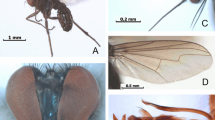Abstract
Diesingium lomentaceum (Diesing, 1850) Pintner, 1929 is redescribed from specimens from Mustelus mustelus (Linnaeus, 1758) from Senegal, Africa, and the genus rehabilitated. Mustelicola Dollfus, 1969 is considered a synonym of Diesingium Pintner, 1929, and D. lomentaceum is considered very similar to D. woodsholei (Dollfus, 1969) n. comb. D. antarcticus (Campbell & Beveridge, 1988) n. comb. is regarded as a valid species. The redefinition of the family Mustelicolidae Dollfus, 1969 sensu Campbell & Beveridge (1988) includes the features of Diesingium.
Similar content being viewed by others
References
Beveridge, I. & Campbell, R.A. (1989) Chimaerarhynchus n. g. and Patellobothrium n. g., two new genera of trypanorhynch cestodes with unique poeciloacanthous armatures, and a reorganisation of the poeciloancanthous trypanorhynch families. Systematic Parasitology, 14, 209–225.
Campbell, R.A. & Beveridge, I. (1988) Mustelicola antarcticus sp. nov. (Cestoda: Trypanorhyncha) from Australian elasmobranchs, and a reassessment of the family Mustelicolidae Dollfus, 1969. Transactions of the Royal Society of South Australia, 111, 153–161.
Compagno, L.J.V. (1984) Sharks of the world. FAO Fisheries Synopsis, 125(4), FAO Species Catalogue, Rome, 655 pp.
Diesing, C.M. (1850) Systema helminthum. Vol. 1. Vindobonae, 679 pp.
Dollfus, R.-Ph. (1942) Etudes critiques sur les tétrarhynques du Muséum de Paris. Archives du Muséum National d'Histoire Naturelle, 19, 1–466.
Dollfus, R.-Ph. (1969) Quelques espèces de cestodes tétrarhynques de la côte Atlantique des Etats-Unis, dont l'une n'était pas connue à l'état adulte. Journal of the Fisheries Research Board of Canada, 26, 1,037–1,061.
Guiart, J. (1931) Considérations historiques sur la nomenclature et sur la classification des Tétrarhynques. Bulletin de l'Institut Océanographique de Monaco, No. 575, 1–27.
Joyeux, C. & Baer, J.G. (1936) Cestodes. Faune de France, 30, 1–613.
Linton, E. (1890) Notes on Entozoa of marine fishes of New England, with descriptions of several new species. Part II. United States Commission of Fish and Fisheries. Report of the Commissioner for 1897. Washington, DC: Part 15, pp. 719–899.
Linton, E. (1924) Notes on cestode parasites of sharks and rays. Proceedings of the United States National Museum, 64, 1–111.
Pintner, T. (1929) Studien über Tetrarhynchen nebst Beobachtungen an der anderen bandwürmern. IV. Mitteilung. Über einige Diesing'sche Originale und verwandte Formen. Österreichische Akademie der Wissenschaften, Wien, Mathematisch Naturwissenschaffliche Klass, 138, 145–166.
Schmidt, G. D. (1986) CRC handbook of tapeworm identification. Boca Raton: CRC Press, 675 pp.
Wardle, R.A. & McLeod, J.A. (1952) The zoology of tapeworms. Minneapolis: University of Minnesota Press, 780 pp.
Yamaguti, S. (1959) Systema helminthum. Vol. II. The cestodes of vertebrates. New York: Interscience Publishers, 860 pp.
Author information
Authors and Affiliations
Rights and permissions
About this article
Cite this article
Beveridge, I., Campbell, R.A. Redescription of Diesingium lomentaceum (Diesing, 1850) (Cestoda: Trypanorhyncha). Syst Parasitol 27, 149–157 (1994). https://doi.org/10.1007/BF00012273
Accepted:
Issue Date:
DOI: https://doi.org/10.1007/BF00012273



